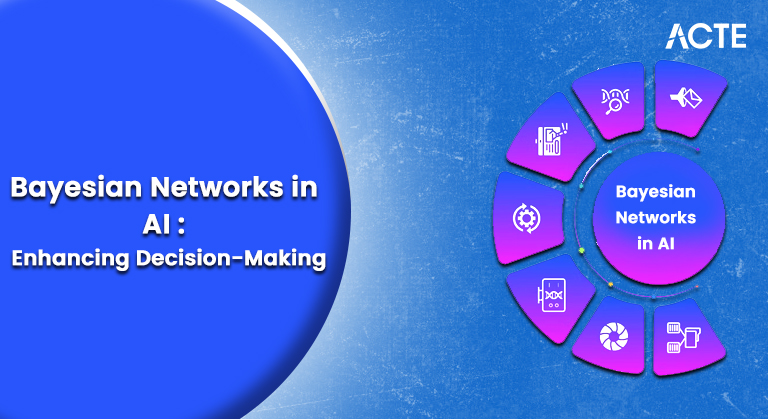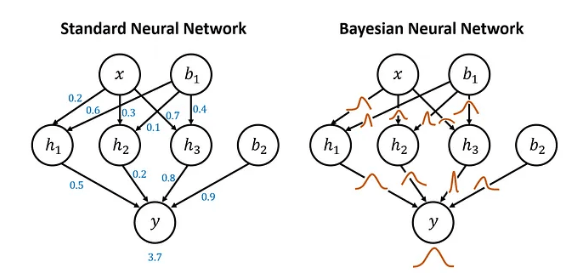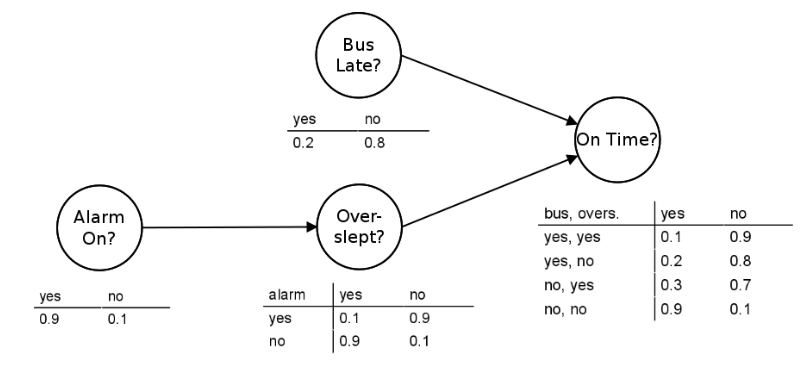
- Introduction to Bayesian Networks
- Bayesian Networks vs Neural Networks
- Applications of Bayesian Networks in AI
- Bayesian Networks in Machine Learning
- Building a Bayesian Network from Data
- Challenges in Implementing Bayesian Networks
- Bayesian Networks in Decision-Making Systems
- Future Scope of Bayesian Networks in AI
Introduction to Bayesian Networks
Bayesian Networks (BNs) are powerful tools in artificial intelligence (AI) and machine learning. They provide a graphical representation of probabilistic relationships among a set of variables. Bayesian Networks are widely used for reasoning under uncertainty, allowing for modeling complex systems in which variables are interdependent. This probabilistic approach, often emphasized in Data Science Training, is based on Bayes’ theorem, which allows updating beliefs about the world in light of new evidence. Judea Pearl introduced the concept of Bayesian Networks in the 1980s, and it has since evolved into one of the most essential tools in AI for handling uncertainty, decision-making, and predictive modeling. These networks are beneficial in domains like medical diagnosis, risk analysis, decision-making systems, and artificial intelligence applications that require reasoning and prediction in uncertainty.
Are You Interested in Learning More About Data Science? Sign Up For Our Data Science Course Training Today!
Bayesian Networks vs Neural Networks
Structure:
- Bayesian Networks: Structured as directed acyclic graphs (DAGs) where nodes represent variables, and edges represent probabilistic dependencies.
- Neural Networks: Composed of interconnected nodes (neurons) layers, which process inputs through nonlinear activation functions.
Probabilistic vs. Deterministic:
- Bayesian Networks: Probabilistic in nature; they explicitly model uncertainty using probability distributions and are ideal for reasoning under uncertainty.
- Neural Networks: Are deterministic; they learn patterns from data through backpropagation and optimization algorithms without an explicit model of uncertainty, a concept introduced in the Basics of Data Science.
Interpretability:
- Bayesian Networks: Highly interpretable because they explicitly model the relationships between variables, making them suitable for tasks where understanding the reasoning process is essential (e.g., decision support).
- Neural Networks: Often seen as “black-box” models due to their complex architecture and difficulty interpreting their internal workings.
- Bayesian Networks: Best suited for reasoning under uncertainty, decision-making, and diagnosis (e.g., medical diagnosis, risk analysis).
- Neural Networks: Used in tasks that require pattern recognition and function approximation (e.g., image recognition, natural language processing).
- Medical Diagnosis: Bayesian Networks model complex relationships between symptoms, diseases, and treatments. By analyzing observed symptoms (evidence), the network can help diagnose the Probability of various diseases.
- Risk Analysis: In industries like finance and insurance, Bayesian Networks can model varmultiplesk factors and their dependencies, assisting organizations in assessing the likelihood of different risks occurring.
- Natural Language Processing: Bayesian Networks can model linguistic dependencies and be used for tasks such as part-of-speech tagging, word sense disambiguation, and machine translation, which are essential skills for Becoming a Successful NLP Engineer.
- Medical Treatment Planning: Bayesian Networks are useful in personalized medicine by helping doctors determine the most likely outcomes of different treatment options based on patient-specific data and medical history, improving decision-making in treatment planning.
- Supply Chain Optimization: In logistics and supply chain management, Bayesian Networks can be used to model and predict the behavior of various supply chain factors (such as demand fluctuations, transportation delays, and inventory levels), enabling more efficient planning and risk management.
- Data Collection: Gather relevant data, ensuring it captures the relationships between variables you want to model.
- Structure Learning: This step consists of discovering the Bayesian Network’s structure. Various algorithms are used for this, such as the constraint-based approach (e.g., the PC algorithm) or score-based methods (e.g., the K2 algorithm).
- Parameter Learning: The conditional probability distributions (CPDs) are learned from the data once the structure is determined. This can be done using maximum likelihood estimation for Bayesian estimation.
- Inference: After building the network, inference can be performed to make predictions or calculate probabilities based on the evidence provided, a process commonly covered in Data Science Training.
- Model Evaluation: This can be done by comparing the predicted outcomes with real data, calculating metrics such as accuracy, precision, recall, or using cross-validation techniques to assess the model’s generalizability.
- Model Validation: In this step, the model is validated by checking if the learned relationships and dependencies accurately reflect real-world scenarios.
- Model Refinement: Based on the evaluation and validation results, the Bayesian Network may need to be refined. This could involve adjusting the structure, re-learning parameters, or incorporating additional data to improve accuracy, robustness, and overall performance.
- Computational Complexity: Exact inference can be computationally expensive, especially for large networks with many variables and complex dependencies.
- Data Availability: Learning the structure and parameters of a Bayesian Network requires high-quality, sufficient data, which may be difficult to obtain in some cases, similar to the challenges faced while generating MIS Reports in Excel.
- Complexity of Structure Learning: Discovering the optimal structure of the network from data is difficult, as it involves exploring a large space of possible configurations.
- Scalability: As the network size increases, managing and performing inference on large-scale Bayesian Networks can become impractical.

Use Cases:
Applications of Bayesian Networks in AI
Bayesian Networks have a wide range of applications in AI, particularly in areas where uncertainty and probabilistic reasoning are essential. Some key applications include:
To Explore Data Science in Depth, Check Out Our Comprehensive Data Science Course Training To Gain Insights From Our Experts!
Bayesian Networks in Machine Learning
In machine learning, Bayesian Networks play a crucial role in modeling uncertainty and complex dependencies between variables. Their ability to provide probabilistic outputs makes them especially valuable in both supervised and unsupervised learning tasks, where the goal is to predict or classify data under uncertainty. In supervised learning, Bayesian Networks can be trained using labeled data to learn the conditional dependencies between input features and output labels, allowing for accurate predictions and classifications a skill that can significantly influence a Data Scientist Salary in India. They are particularly useful when dealing with incomplete or noisy data, as they can effectively model uncertainty and provide robust outcomes. In unsupervised learning, Bayesian Networks can be applied to clustering tasks by identifying latent variables and probabilistic dependencies between data points, which helps reveal hidden structures or patterns in the data.

Additionally, Bayesian Networks can be integrated with other machine learning algorithms, such as neural networks, to create hybrid models that capitalize on the strengths of both approaches. This combination can enhance model accuracy, efficiency, and versatility, making it ideal for complex, high-dimensional datasets. Overall, Bayesian Networks are a powerful tool for tackling uncertainty and enhancing the performance of machine learning systems.
Building a Bayesian Network from Data
Looking to Master Data Science? Discover the Data Science Masters Course Available at ACTE Now!
Challenges in Implementing Bayesian Networks
While Bayesian Networks are a powerful tool, there are challenges involved in their implementation:
Bayesian Networks in Decision-Making Systems
Bayesian Networks are essential in decision-making systems, particularly when uncertainty is a key factor. These networks provide a powerful framework for evaluating different courses of action, taking into account risks, probabilities, and potential outcomes. In healthcare, for example, Bayesian Networks support medical decision-making by helping doctors assess patient data and determine the most probable diagnosis or treatment plan. They model complex relationships between symptoms, diseases, and treatments, allowing for more accurate predictions in medical scenarios. In finance, Bayesian Networks play a vital role in portfolio management, where they assess the likelihood of various investment outcomes, often complemented by different Types of Data Visualization to aid decision-making. By evaluating the conditional dependencies between market variables, they help investors make informed decisions about risk and return. Similarly, in autonomous vehicles, Bayesian Networks are used in decision-making systems to evaluate risks and drive decisions based on real-time sensor data. These networks help self-driving cars assess their environment, make predictions about potential obstacles, and choose the safest course of action. Overall, Bayesian Networks are invaluable tools across industries, providing a structured approach to managing uncertainty and guiding decisions with greater confidence.
Preparing for a Data Science Job Interview? Check Out Our Blog on Data Science Interview Questions & Answer
Future Scope of Bayesian Networks in AI
The future of Bayesian Networks in AI holds great promise, with several exciting advancements and applications on the horizon. One significant development is the integration of Bayesian Networks with deep learning models, creating more robust systems capable of handling uncertainty while benefiting from the power of neural networks. This combination could lead to more effective and reliable AI systems. Additionally, with advancements in computational power and algorithms, Bayesian Networks often explored in Data Science Training may be used for real-time decision-making in critical areas such as autonomous systems, robotics, and healthcare, where immediate responses are crucial.Furthermore, ongoing research into more efficient algorithms for structure learning, parameter estimation, and inference will enhance the scalability of Bayesian Networks, making them applicable to larger and more complex datasets. As industries increasingly adopt AI technologies, Bayesian Networks are expected to play a key role in sectors like finance, healthcare, manufacturing, and logistics, enabling more accurate predictions and better decision-making. In conclusion, Bayesian Networks remain essential for modeling uncertainty and making informed decisions, and the development of more efficient methods will ensure their continued importance in the future of AI.



